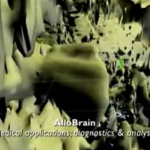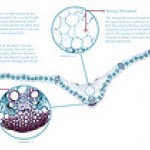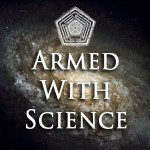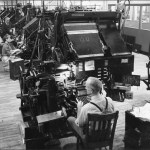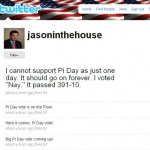Web 2.0, New Media, and Gadgets
In her recent TED talk, JoAnne Kuchera-Morin described UCSB's AlloSphere, a new project that enables scientists to literally stand inside a three-story projection of their data:
The AlloSphere space consists of a 3-story cube that is treated with extensive sound absorption material making it one of the largest anechoic chambers in the world. Standing inside this chamber are two 5-meter-radius hemispheres constructed of perforated aluminum that are designed to be optically opaque and acoustically transparent. (source)
Scientists and artists can stand on a bridge through the center of this…
Here's one perspective on why journalism training is a bad idea:
I like to joke that I'm "unqualified" to do my job. But I think it was precisely that total lack of journalism training that gave me an edge. I never worked the cops-and-courts beat. I don't know how to write an inverted pyramid story or even really what that is. I do know how to write for different platforms, be scrappy and break news. I've had zero important alum connections and never got an internship at a big daily. And, in hindsight, that's probably the greatest stroke of luck I could have had. Journalism schools are like…
Zea Poster from m f's flickr stream
Michael Franklin, Rochester Institute of Technology
One of the ways in which I can foresee Web 2.0 applications changing the culture of science is by increasing avenues for mentorship. Web apps allow students from different departments, universities, and nations to connect, collaborate, and exchange advice. This can mean career-changing help for students at small institutions (or for those at large institutions with poor interdepartmental relations or a dearth of experts in a particular field). I'm not just talking about help troubleshooting protocols; far…
Scibling Bora has expressed his wish "to end once for all the entire genre of discussing the "bloggers vs. journalists" trope," and tried to do so with perhaps the most massive science-journalism-Web2.0 post evah.
Bora says,
the whole "bloggers will replace journalists" trope is silly and wrong. No, journalists will replace journalists. It's just that there will be fewer of them paid, and more of us unpaid. Some will be ex-newspapermen, others ex-bloggers, but both will be journalists. Instead of on paper, journalism will happen online. Instead of massaging your article to fit into two inches…
What's that you say? You still haven't joined Twitter? You don't see the point of constant 140-character status updates? Well, that's suddenly okay! You can emulate the many developing third-world nations who leaped directly over landline telephones to cell networks, and bypass Twitter entirely for the next big thing: Flutter.
Now what we really need to do is figure out ways to harness Flutter to replace the mainstream media and transform science. Imagine lab goggles with your friends' "flaps" scrolling across them: you'll never need to leave the bench to "have a life!" w00t!
Via…
It's just not Google's week. A mob of angry villagers north of London formed human chains and chased off the Google Maps car (no word whether they had torches). Microsoft is all up in Google's business (to be precise, they're funding a team at New York Law School's Institute for Information Law and Policy, led by a former Microsoft programmer, which is weighing in on the pending settlement of Google's book-scanning lawsuit). And it's not just Microsoft that's taking aim at Google: the NYT has an overview of the many parties, from librarians to law professors, who have serious doubts about…
Jacek Utko argues that there is no convincing reason why newspapers should survive - but that good design might be able to transform them into something more successful. In addition to numerous awards, Utko's fearless use of white space, bold color, and dramatic imagery has won significant increases in readership (up to 100%) for several Eastern European newspapers.
A real newspaper redesign involves more than changing the layout. The layout is essential, but by no means the only element. First we define the goal, later the necessary content-changes, and only then do we get to design.…
My friend John Ohab is hosting a new DoD webcast called "Armed With Science." Sure, it has an over-the-top logo reminiscent of the Syfy Channel (I like to intone "ARMED WITH SCIENCE" with the same cadence as "PIGS IN SPACE!"), but the show turns out to be really well-done and interesting. Each episode is a half-hour interview with a researchers in a scientific field relevant to the military: sometimes that means SONAR or geopositioning, but they also take on general science topics like Brain Awareness Week at the National Museum of Health and Medicine. It's a nice mix of topics, and it's…
SEEDmagazine.com interviews Carl Bergstrom, whose eigenfactor project uses citation databases to map networks of information sharing within science:
We find papers to read by following citation trails. If you have an eigenfactor of 1.5, it means 1.5% of the time, a researcher following citation trails is actually trying to get an article from your journal. . . How do you make the right connections, right? How do you make the critical connections to move thought forward? If you can solve a problem like that, or even just make a little contribution to it, it really accelerates science in a…
Linotype operators work in the composing room at the P-I building at 6th and Wall Street in December, 1948. (Seattle Post-Intelligencer photo)
To follow up on my post about science journalism and blogs, a few reading links dealing with science in society, journalism, and the transformation of media.
First, Peter Dizikes revisits C.P. Snow's ubiquitous "two cultures", fifty years later:
"The Two Cultures" actually embodies one of the deepest tensions in our ideas about progress. Snow, too, wants to believe the sheer force of science cannot be restrained, that it will change the world -- for…
Illustration by David Parkins, Nature
Today, Nature released a news feature by Geoff Brumfiel on the downturn in mainstream science media. We've all known that this is happening; the alarms become impossible to ignore when Peter Dysktra and his team at CNN lost their jobs last year. For mainstream outlets like CNN or the Boston Globe to cut science may seem appalling - but in an unforgiving economic climate which has already triggered the collapse of major newspapers like the Seattle Post-Intelligencer, such cuts are logical, because science reporting isn't a big money-maker. The question…
You've probably heard about the man with the eyeball camera. Here's the most detailed (and sometimes graphic) video I've yet seen about documentary filmmaker Rob Spence (aka Eyeborg), who is working on getting his prosthetic eye replaced with a wireless eye socket camera:
I first encountered Spence in this writeup at Wired last fall. According to the new video, they've hit a few snags since then, but for some reason Spence is all over the news right now. And it's a safe bet he'll continue to be, if he becomes the first cyborg reporter with a bionic eyecamera!
More: a briefer AP video on…
The Pi Day bill went up for a vote today and passed 391-10. Now Congressman Jason Chaffetz explains (via Twitter, natch) why he dared vote against the hallowed number:
Fie, fie! No Yes PeCan Pi for you, Representative Chaffetz (R-Utah)! But kudos for a creative excuse.
The Shakespeare Insult meme takes a portable turn with the Shakespeare Insulter for iPhone.
This app is supposedly "official" (who says?) but strangely, it features an American voice, which issues from the nutcracker-jawed head of the Bard like that of a self-important postmodernist literary scholar who is unaware of his tendency toward melodrama. "Thou" becomes an interminable "Th-owwwwwwwww", followed by any two random adjectives and noun. There's nothing innovative about it, no way to customize it, and apparently no way to speed the darn thing up. Two bitten thumbs down! Get this app to…
In this video, the independent publisher of the forthcoming novel "Pride and Prejudice and Zombies" expresses confusion and surprise that his acquisition went viral! Look, dude: it's about zombies. Have you even been on the intertubes before?
I have two physics-based games to plug: Crayon Physics and Fantastic Contraption.
Crayon Physics is, well, just watch the demo:
Crayon Physics Deluxe from Petri Purho on Vimeo.
Cool, huh? The promo trailer reminds me of Line Rider (an online/iPhone doodling game) crossed with Fantastic Contraption (an online physics puzzle game, soon to be on the iPhone as well).
I once spent an afternoon trying to figure out Fantastic Contraption, but it confused the heck out of me. Still, it's free, addictive, and makes people stop and say "what are you doing?" Line Rider is more my speed, and since I can…
Weirdest lede ever?
A giant flower beetle with implanted electrodes and a radio receiver on its back can be wirelessly controlled, according to research presented this week.
Go DARPA!
Article (MIT Technology Review) here. Video here.
Photographer David Bergman created this gigapixel panorama of the Inauguration, which enables you to play "Where's Waldo" with folks like Al Gore and Newt Gingrich, count the snipers deployed around the Capitol, mercilessly mock folks who fell asleep during the ceremony, and generally goggle at the greatness of technology. This is a better view than you'd have had were you actually there!
(Bergman says on his blog, "I've only just started to explore the photo myself, but I found Yo-Yo Ma taking a picture with his iPhone.")
PS. A friend pointed out that users at the gigapan web site are…
I hate Battlefield Earth not because it's a bad movie - bad movies can be fun! - but because it's so unrelentingly bad, by the end I was just plain depressed that it existed. The same goes for this truly ghastly ad for Microsoft Songsmith. At first I thought it had to be a spoof. But. . . I'm afraid not (there's a demo here).
If they wanted a musical, they needed to call Joss Whedon. (And make a better product).
Via Stephen Fry's twitterfeed. (Yes, that Stephen Fry).
ScienceOnline09 kicks off tonight. Formerly known as the Duke Blogging Conference, it's a weekend of interactive sessions on science blogging with lots of Sciblings and others representing the science blogging collective. Follow along on the conference wiki or Scibling Bora's blog for all the details.
I am extremely disappointed that I am too sick to go and co-chair the arts sessions with Glendon Mellow, but I made the right decision, because I am not getting better - I spent Wednesday at the State of the Net conference only a few miles from home, and I was destroyed afterward. I'll be…
